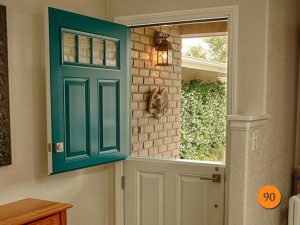This dutch door reminds me of having good boundaries. You are able to monitor who you let in. You can see if it is someone who will treat you well and you want in your “house”. You can close it all the way if you don’t, open it up if you do, and if you want to see who is there–talk to them, get a feel for if they will or won’t treat you with kindness and respect. But stay a while til you decide to open or close the door.
I have used this metaphor with clients to help them understand what it means to have boundaries that help them manage who they want in their life as well as when. When people have unhealthy boundaries-they can swing between too rigid boundaries-not letting anyone in, or not allowing their emotional walls come down with their loved ones. Or the other side can be poor boundaries-in which people can’t say no, are unable to make themselves a priority, and can feel like others take advantage of them.
What is a boundary? Technically-it is where I end and someone else begins. According to Ryan Howes, PhD, a clinical psychologist in Pasadena, CA, in healthy relationships partners “ask permission, take one another’s feelings into account, show gratitude and respect differences in opinion, perspective and feelings.” However, In less healthy relationships, partners assume their partner feels the same way they do (e.g., “I like this, so you must, too”). They ignore the effects of violating their partner’s boundary (e.g., “They’ll get over it”).
I like this picture of the dutch door, especially because it has a set of windows up on top. If you aren’t sure who is there, or if they are safe or harmful (like the big, bad wolf)-you could always get a chair and look out front before you decide to let someone in.

